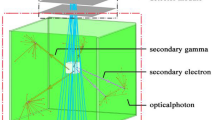Abstract
Purpose
The research focuses on the related designing and simulating the high-position-resolution trajectory detector system based on cosmic ray muon tomography.
Methods
The energy deposition of muon in the detector varies with the length of the ionization path.
Results
The simulation of the submillimeter detector system was designed for muon imaging. The optimal position resolution of the detector reached 0.6 mm.
Conclusions
The entire research process includes the selection of analysis of parameters affecting system design, designing of two high-position-resolution detectors based on plastic scintillators, implementation of different imaging algorithms and image quality assessment based on different imaging models. It provides a solution based on high positional resolution plastic scintillator detectors for cosmic ray muon scattering imaging.
















Similar content being viewed by others
Data availability
The data that support the findings of this study are available from the corresponding author upon reasonable request.
References
S.I. Eidelman, “Interactions of particles and radiation with matter in handbook of particle detection and imaging (Springer, New York, 2011)
K. Morishima et al., Discovery of a big void in Khufu’s Pyramid by observation of cosmic-ray muons. Nat. Publ. Group 552(7685), 386–390 (2017). https://doi.org/10.1038/nature24647
L.J. Schultz, Cosmic ray muon radiography (Portland State University, 2003)
C.M. Liu, Q.G. Wen, Z.Y. Zhang, G.S. Huang, Study of muon tomographic imaging for high-Z material detection with a Micromegas-based tracking system. Radiation Detect Technol Methods (2020). https://doi.org/10.1007/s41605-020-00179-9
K. Gnanvo, L.V. Grasso, M. Hohlmann, J.B. Locke, A. Quintero, D. Mitra, Imaging of high-Z material for nuclear contraband detection with a minimal prototype of a muon tomography station based on GEM detectors. Nucl. Instrum. Methods Phys. Res., Sect. A 652(1), 16–20 (2011). https://doi.org/10.1016/j.nima.2011.01.163
W.C. Priedhorsky et al., Detection of high-Z objects using multiple scattering of cosmic ray muons. Rev. Sci. Instrum. 74(10), 4294–4297 (2003). https://doi.org/10.1063/1.1606536
X. Wang et al., The cosmic ray muon tomography facility based on large scale MRPC detectors. Nucl. Instrum. Methods Phys. Res., Sect. A 784, 390–393 (2015). https://doi.org/10.1016/j.nima.2015.01.024
J. Pan et al., “Position Encoding Readout Electronics of Large Area Micromegas Detectors aiming for Cosmic Ray Muon Imaging,” 2019 IEEE Nuclear Science Symposium and Medical Imaging Conference, NSS/MIC 2019, pp. 1–5, 2019, doi: https://doi.org/10.1109/NSS/MIC42101.2019.9060024
S. Basnet et al., Towards portable muography with small-area, gas-tight glass resistive plate chambers. J. Instrumentation 15, 10 (2020). https://doi.org/10.1088/1748-0221/15/10/C10032
V. Anghel et al., A plastic scintillator-based muon tomography system with an integrated muon spectrometer. Nucl. Instrum. Methods Phys. Res., Sect. A 798, 12–23 (2015). https://doi.org/10.1016/j.nima.2015.06.054
S. Agostinelli, J. Allison, K. Amako, J. Apostolakis, H. Araujo, Geant 4 — a simulation toolkit. Nucl. Phys. News 506, 250–303 (2003). https://doi.org/10.1016/S0168-9002(03)01368-8
C. Hagmann, D. Lange, and D. Wright, “Cosmic-ray shower generator (CRY) for Monte Carlo transport codes,” IEEE Nuclear Science Symposium Conference Record, vol. 2, pp. 1143–1146, 2007, doi: https://doi.org/10.1109/NSSMIC.2007.4437209
L.J. Schultz et al., Statistical reconstruction for cosmic ray muon tomography. IEEE Trans. Image Process. 16(8), 1985–1993 (2007). https://doi.org/10.1109/TIP.2007.901239
K.A. Olive et al., Review of particle physics. Chinese Phys. C 38, 9 (2014). https://doi.org/10.1088/1674-1137/38/9/090001
J.W. Motz, H. Olsen, H.W. Koch, Electron scattering without atomic or nuclear excitation. Rev. Mod. Phys. 36(4), 881–928 (1964). https://doi.org/10.1103/RevModPhys.36.881
G.R. Lynch, O.I. Dahl, Approximations to multiple Coulomb scattering. Nucl. Inst. Methods Phys. Res., B 58(1), 6–10 (1991). https://doi.org/10.1016/0168-583X(91)95671-Y
C.T. Case, E.L. Battle, Molière’s theory of multiple scattering. Phys. Rev. 169(1), 201–204 (1968). https://doi.org/10.1103/PhysRev.169.201
L.J. Schultz et al., Image reconstruction and material Z discrimination via cosmic ray muon radiography. Nucl. Instrum. Methods Phys. Res., Sect. A 519(3), 687–694 (2004). https://doi.org/10.1016/j.nima.2003.11.035
X.-D. Wang et al., “The Study of Cosmic Ray Tomography Using Multiple Scattering of Muons for Imaging of High-Z Materials,” vol. XX, no. 12, pp. 1–11, 2016, [Online]. Available: http://arxiv.org/abs/1608.01160.
C.J. Benton, N.D. Smith, S.J. Quillin, C.A. Steer, Most probable trajectory of a muon in a scattering medium, when input and output trajectories are known. Nucl. Inst. Methods Phys. Res., A 693, 154–159 (2012). https://doi.org/10.1016/j.nima.2012.07.008
H. Yi et al., “Bayesian-theory-based most probable trajectory reconstruction algorithm in cosmic ray muon tomography,” 2014 IEEE Nuclear Science Symposium and Medical Imaging Conference, NSS/MIC 2014, pp. 1–4, 2016, doi: https://doi.org/10.1109/NSSMIC.2014.7431084
Acknowledgements
This work was supported by the National Natural Science Foundation of China (Grant No. U2067206 and No. U1932162). The authors would like to thank all those who have contributed in one way or another to the realization of this work, especially the research groups of Yuekun Heng and Xingzhong Cao from the Institute of High Energy Physics Chinese Academy of Sciences.
Author information
Authors and Affiliations
Corresponding author
Rights and permissions
About this article
Cite this article
Zhai, J., Tang, H., Huang, X. et al. A high-position-resolution trajectory detector system for cosmic ray muon tomography: Monte Carlo simulation. Radiat Detect Technol Methods 6, 244–253 (2022). https://doi.org/10.1007/s41605-022-00313-9
Received:
Revised:
Accepted:
Published:
Issue Date:
DOI: https://doi.org/10.1007/s41605-022-00313-9




